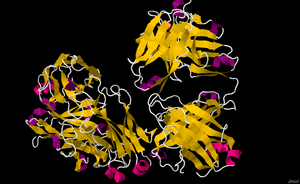User:Mr. Ibrahem/Rituximab
 | |
| Monoclonal antibody | |
|---|---|
| Type | Whole antibody |
| Source | Chimeric (mouse/human) |
| Target | CD20 |
| Clinical data | |
| Trade names | Rituxan, MabThera, Truxima, others[1] |
| Other names | Rituximab-abbs, rituximab-pvvr |
| AHFS/Drugs.com | Monograph |
| MedlinePlus | a607038 |
| License data | |
| Pregnancy category |
|
| Routes of administration | Intravenous infusion |
| Drug class | Monoclonal antibody |
| Legal status | |
| Legal status | |
| Pharmacokinetic data | |
| Bioavailability | 100% (IV) |
| Elimination half-life | 30 to 400 hours (varies by dose and length of treatment) |
| Excretion | Uncertain: may undergo phagocytosis and catabolism in RES |
| Chemical and physical data | |
| Formula | C6416H9874N1688O1987S44 |
| Molar mass | 143860.04 g·mol−1 |
| | |
Rituximab, sold under the brand name Rituxan among others, is a medication used to treat certain autoimmune diseases and types of cancer.[3] It is used for non-Hodgkin lymphoma, chronic lymphocytic leukemia, rheumatoid arthritis, granulomatosis with polyangiitis, idiopathic thrombocytopenic purpura, pemphigus vulgaris, myasthenia gravis, and Epstein–Barr virus-positive mucocutaneous ulcers.[3][5][6][7] It is given by slow injection into a vein.[3] Short courses are sometimes repeated after 6 months.[8]
Common side effects may include rash, itchiness, low blood pressure, and shortness of breath.[3] Other severe side effects include reactivation of hepatitis B in those previously infected, progressive multifocal leukoencephalopathy, and toxic epidermal necrolysis.[3][9] It is unclear if use during pregnancy is safe for the baby.[2][3] Effective pregnancy prevention is advised during treatment and for a year after.[10] Rituximab is a chimeric monoclonal antibody against the protein CD20, which is primarily found on the surface of immune system B cells.[11] When it binds to this protein it triggers cell death.[3]
Rituximab was approved for medical use in 1997.[11] It is on the World Health Organization's List of Essential Medicines.[12] The wholesale price in the developing world as of 2014 was US$148–496 per 100 mg.[13] In the United Kingdom it generally costs the NHS around £150 for a vial of 100mg in 2021.[10] In the United States this is about $705 in 2014.[14] The typical treatment for rheumatoid arthritis (1,000 mg IV dose, 2 weeks apart) in the United States would have been $14,000 a month in 2014.[14] The patent expired in 2016 and a number of biosimilars have been launched.[15]
References[edit]
- ^ Drugs.com International brand names for rituximab Archived 2016-04-22 at the Wayback Machine Page accessed 1 April 2016
- ^ a b c "Rituximab Use During Pregnancy". Drugs.com. 16 December 2019. Archived from the original on 30 August 2019. Retrieved 2 February 2020.
- ^ a b c d e f g h i "Rituximab". The American Society of Health-System Pharmacists. Archived from the original on 27 March 2016. Retrieved 8 December 2016.
- ^ "WHOCC - ATC/DDD Index". www.whocc.no. Archived from the original on 29 October 2020. Retrieved 17 September 2020.
- ^ Tandan, Rup; Hehir, Michael K.; Waheed, Waqar; Howard, Diantha B. (August 2017). "Rituximab treatment of myasthenia gravis: A systematic review". Muscle & Nerve. 56 (2): 185–196. doi:10.1002/mus.25597. ISSN 1097-4598. PMID 28164324.
- ^ Singer, O; McCune, WJ (May 2017). "Update on maintenance therapy for granulomatosis with polyangiitis and microscopic polyangiitis". Current Opinion in Rheumatology. 29 (3): 248–253. doi:10.1097/BOR.0000000000000382. PMID 28306595.
- ^ Dojcinov SD, Fend F, Quintanilla-Martinez L (March 2018). "EBV-Positive Lymphoproliferations of B- T- and NK-Cell Derivation in Non-Immunocompromised Hosts". Pathogens (Basel, Switzerland). 7 (1): 28. doi:10.3390/pathogens7010028. PMC 5874754. PMID 29518976.
{{cite journal}}: CS1 maint: unflagged free DOI (link) - ^ Shagroni, T.; Cazares, Ramirez; Kim, J. A.; Furst, Daniel E. (2020). "36. Nonsteroidal anti-inflammatory drugs, disease-modifying antirheumatic drugs, nonopioid analgesics, & drugs used in gout". In Katzung, Bertram G.; Trevor, Anthony J. (eds.). Basic and Clinical Pharmacology (15th ed.). New York: McGraw-Hill. p. 678. ISBN 978-1-260-45231-0. Archived from the original on 10 October 2021. Retrieved 6 November 2021.
- ^ "Boxed Warning and new recommendations to decrease risk of hepatitis B". U.S. Food and Drug Administration (FDA). 13 January 2017. Archived from the original on 3 February 2020. Retrieved 2 February 2020.
- ^ a b "8. Immune system and malignant disease". British National Formulary (BNF) (82 ed.). London: BMJ Group and the Pharmaceutical Press. September 2021 – March 2022. pp. 933–934. ISBN 978-0-85711-413-6.
{{cite book}}: CS1 maint: date format (link) - ^ a b Bosch, Xavier; Ramos-Casals, Manuel; Khamashta, Munther A. (2013). Drugs Targeting B-Cells in Autoimmune Diseases. Springer Science & Business Media. pp. 1–4. ISBN 9783034807067. Archived from the original on 2017-11-05.
- ^ World Health Organization (2019). World Health Organization model list of essential medicines: 21st list 2019. Geneva: World Health Organization. hdl:10665/325771. WHO/MVP/EMP/IAU/2019.06. License: CC BY-NC-SA 3.0 IGO.
- ^ "Rituximab". International Drug Price Indicator Guide. Archived from the original on 22 January 2018. Retrieved 28 November 2015.
- ^ a b "Drugs for Rheumatoid Arthritis". The Medical Letter. 56 (1458): 127–32. 22 December 2014.
- ^ "Rituximab Biosimilars Shown to Be Safe and Effective". www.medscape.com. Archived from the original on 15 March 2018. Retrieved 29 November 2017.
